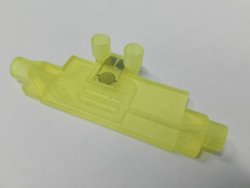Manufacturing Microfluidics with 3D printing
Drs. ing. Jan Eite Bullema, Senior Scientist at TNO Technical Sciences
 3D Printing / Additive Manufacturing appears to be an attractive technology to realize fluidic devices. By many still mainly seen as technology for development purposes, as 3D printing makes it relative easy to make small series with design iterations (e.g. different inlet apertures, different channel length, mixer size). In fact 3D printing evolves rapidly as a manufacturing technology. This is especially true for fluidic devices that have a more complex design – like many organ-on-chip devices. Recent developments in 3D printing have made 3D printing more attractive as a manufacturing technology. Dolomite has introduced the Fluidic Factory 3D printer for fast prototyping. The Continuous Liquid Interface Process (CLIP) announced by Carbon in the beginning of 2015, makes VAT polymerization 100 timed faster. Carbon has demonstrated (and patented) production of microfluidic products. At TNO we have developed production equipment that enable low cost production of integrated microfluidics with 3D printing.
3D Printing / Additive Manufacturing appears to be an attractive technology to realize fluidic devices. By many still mainly seen as technology for development purposes, as 3D printing makes it relative easy to make small series with design iterations (e.g. different inlet apertures, different channel length, mixer size). In fact 3D printing evolves rapidly as a manufacturing technology. This is especially true for fluidic devices that have a more complex design – like many organ-on-chip devices. Recent developments in 3D printing have made 3D printing more attractive as a manufacturing technology. Dolomite has introduced the Fluidic Factory 3D printer for fast prototyping. The Continuous Liquid Interface Process (CLIP) announced by Carbon in the beginning of 2015, makes VAT polymerization 100 timed faster. Carbon has demonstrated (and patented) production of microfluidic products. At TNO we have developed production equipment that enable low cost production of integrated microfluidics with 3D printing.
 With 3D printing technology it becomes possible to manufacture functional 3D fluidic structures, e.g. serpentine mixers, Brownian ratchets, Tesla valves. 3D printing makes it also possible to easily integrate fluidic functionalities, like mixing, valving, metering in one device. Which leads to a reduction of integral device costs. It is expected that especially for complex integrated lab-on-a-chip / organ-on-a-chip devices, 3D printing will become the production technology of choice.
With 3D printing technology it becomes possible to manufacture functional 3D fluidic structures, e.g. serpentine mixers, Brownian ratchets, Tesla valves. 3D printing makes it also possible to easily integrate fluidic functionalities, like mixing, valving, metering in one device. Which leads to a reduction of integral device costs. It is expected that especially for complex integrated lab-on-a-chip / organ-on-a-chip devices, 3D printing will become the production technology of choice.
